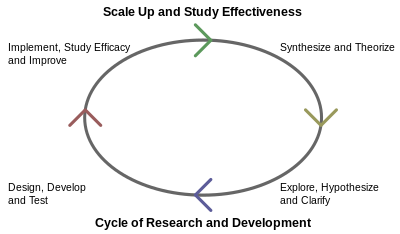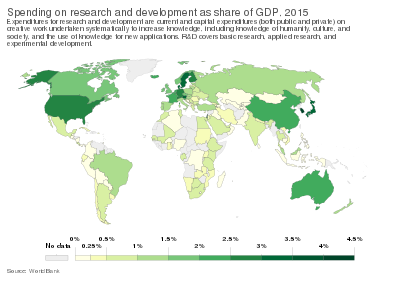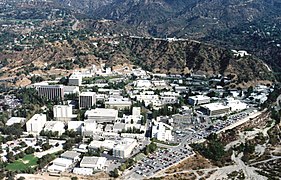Clinfowiki
Contents


Research and development (R&D or R+D)[1] is the set of innovative activities undertaken by corporations or governments in developing new services or products.[2][3][4] R&D constitutes the first stage of development of a potential new service or the production process.
Although R&D activities may differ across businesses, the primary goal of an R&D department is to develop new products and services.[2][4] R&D differs from the vast majority of corporate activities in that it is not intended to yield immediate profit, and generally carries greater risk and an uncertain return on investment.[2][5] R&D is crucial for acquiring larger shares of the market through new products.[4] R&D&I represents R&D with innovation.[6][7][8]
Background
New product design and development is often a crucial factor in the survival of a company. In a global industrial landscape that is changing fast, firms must continually revise their design and range of products. This is necessary as well due to the fierce competition and the evolving preferences of consumers. Without an R&D program, a firm must rely on strategic alliances, acquisitions, and networks to tap into the innovations of others.
A system driven by marketing is one that puts the customer needs first, and produces goods that are known to sell.[9] Market research is carried out, which establishes the needs of consumers and the potential niche market of a new product. If the development is technology driven, R&D is directed toward developing products to meet the unmet needs.[citation needed]
In general, research and development activities are conducted by specialized units or centers belonging to a company, or can be out-sourced to a contract research organization, universities, or state agencies.[citation needed] In the context of commerce, "research and development" normally refers to future-oriented, longer-term activities in science or technology, using similar techniques to scientific research but directed toward desired outcomes and with broad forecasts of commercial yield.[10]
Statistics on organizations devoted to "R&D" may express the state of an industry, the degree of competition or the lure of progress.[11] Some common measures include: budgets, numbers of patents or on rates of peer-reviewed publications. Bank ratios are one of the best measures, because they are continuously maintained, public and reflect risk.
In the United States, a typical ratio of research and development for an industrial company is about 3.5% of revenues; this measure is called "R&D intensity".[citation needed] A high technology company, such as a computer manufacturer, might spend 7% or a pharmaceutical companies such as Merck & Co. 14.1% or Novartis 15.1%. Anything over 15% is remarkable, and usually gains a reputation for being a high technology company such as engineering company Ericsson 24.9%, or biotech company Allergan, which tops the spending table with 43.4% investment.[12] Such companies are often seen as credit risks because their spending ratios are so unusual.[citation needed]
Generally such firms prosper only in markets whose customers have extreme high technology needs, like certain prescription drugs or special chemicals, scientific instruments, and safety-critical systems in medicine, aeronautics or military weapons. [citation needed]The extreme needs justify the high risk of failure and consequently high gross margins from 60% to 90% of revenues.[citation needed] That is, gross profits will be as much as 90% of the sales cost, with manufacturing costing only 10% of the product price, because so many individual projects yield no exploitable product. Most industrial companies get 40% revenues only.[citation needed]
On a technical level, high tech organizations explore ways to re-purpose and repackage advanced technologies as a way of amortizing the high overhead.[citation needed] They often reuse advanced manufacturing processes, expensive safety certifications, specialized embedded software, computer-aided design software, electronic designs and mechanical subsystems.[citation needed]
Research from 2000 has shown that firms with a persistent R&D strategy outperform those with an irregular or no R&D investment program.[13]
Business R&D

Research and development are very difficult to manage, since the defining feature of research is that the researchers do not know in advance exactly how to accomplish the desired result. As a result, "higher R&D spending does not guarantee more creativity, higher profit or a greater market share".[14] Research is the most risky financing area because both the development of an invention and its successful realization carries uncertainty including the profitability of the invention.[15] One way entrepreneurs can reduce these uncertainties is to buy the licence for a franchise, so that the know-how is already incorporated in the licence.[15]
Benefit by sector
In general, it has been found that there is a positive correlation between the research and development and firm productivity across all sectors, but that this positive correlation is much stronger in high-tech firms than in low-tech firms.[16][17] In research done by Francesco Crespi and Cristiano Antonelli, high-tech firms were found to have "virtuous" Matthew effects while low-tech firms experienced "vicious" Matthew effects, meaning that high-tech firms were awarded subsidies on merit while low-tech firms most often were given subsidies based on name recognition, even if not put to good use.[18] While the strength of the correlation between R&D spending and productivity in low-tech industries is less than in high-tech industries, studies have been done showing non-trivial carryover effects to other parts of the marketplace by low-tech R&D.[19]
Risks
Business R&D is risky for at least two reasons. The first source of risks comes from R&D nature, where R&D project could fail without residual values. The second source of risks comes from takeover risks, which means R&D is appealing to bidders because they could gain technologies from acquisition targets.[20] Therefore, firms may gain R&D profit that co-moves with takeover waves, causing risks to the company which engages in R&D activity.[21]
Global

Global R&D management is the discipline of designing and leading R&D processes globally, across cultural and lingual settings, and the transfer of knowledge across international corporate networks.[23]
Government expenditures
United States
Former President Barack Obama requested $147.696 billion for research and development in FY2012, 21% of which was destined to fund basic research.[24] According to National Science Foundation in U.S., in 2015, R&D expenditures performed by federal government and local governments are 54 and 0.6 billions of dollars.[25] The federal research and development budget for fiscal year 2020 was $156 billion, 41.4% of which was for the Department of Defense (DOD).[26] DOD's total research, development, test, and evaluation budget was roughly $108.5 billion.[27]
-
The Jet Propulsion Laboratory, California
-
Learning Research and Development Center, Pittsburg
-
Mercedes Benz Research Development North America
-
National Museum of the U.S. Air Force-Research and Development Gallery
Israel
Israel is the world leader in spending on R&D as a percentage of GDP as of 2022, spending 6.02%.[28] According to CSIS, During the 1970s and 1980s Israel initially built up Israel's research infrastructure through various programs, often in the defence industry. In 1984, a law for Encouragement of Research and Development in Industry encouraged the commercial sector to invest in R&D in Israel as well as empowered the Office of Chief Scientist In the 1980s to 1992, the Chief scientist of Israel significantly expanded R&D subsidies in the Israeli industrial sector.[29] Israel invested in the creation of clusters of startups in the high-tech sector as well as venture capital investments. In 1993, Israel initiated the Yozma program, which led to the doubling of value of Israel's 10 new venture capital funds in 3 years.[29] In the late 1990s, Israel was second only to the US in private equity as a share of the general economy.[29] The high tech sector in Israel, known as Silicon Wadi, which earned Israel the nickname - Start-up Nation, was ranked the 4th leading startup ecosystem in the world by Startup genome with a value of $253billion in 2023.[30]
-
Microsoft Israel R&D Center
-
General Motors R&D, Israel
-
Technion, Computer Science faculty
-
Weizmann Institute, koffler accelerator
-
Israeli StemRad astronaut anti radiation suit, picture by NASA
European Union
Europe is lagging behind in R&D investments from the past two decades.[according to whom?] The target of 3% of gross domestic product (GDP) was meant to be reached by 2020, but the current amount is below this target. This also causes a digital divide among countries since only a few EU Member States have R&D spending.[31]
Research and innovation in Europe are financially supported by the programme Horizon 2020, which is open to participation worldwide.[32]
A notable example is the European environmental research and innovation policy, based on the Europe 2020 strategy which will run from 2014 to 2020,[33] a multidisciplinary effort to provide safe, economically feasible, environmentally sound and socially acceptable solutions along the entire value chain of human activities.[34]
Firms that have embraced advanced digital technology devote a greater proportion of their investment efforts to R&D. Firms who engaged in digitisation during the pandemic report spending a big portion of their expenditure in 2020 on software, data, IT infrastructure, and website operations.[35][36] A 2021/2022 survey found that one in every seven enterprises in the Central, Eastern and South Eastern regions (14%) may be classed as active innovators — that is, firms that spent heavily in research and development and developed a new product, process, or service — however this figure is lower than the EU average of 18%. In 2022, 67% of enterprises in the same region deployed at least one sophisticated digital technology, and 69% EU firms did the same.[37]
As of 2023, European enterprises account for 18% of the world's top 2 500 R&D corporations, but just 10% of new entrants, compared to 45% in the United States and 32% in China.[38]
As of 2024, the electronics sector leads in R&D investment, with 28% of its total investment dedicated to it. This is followed by textiles (19%), digital (18%), and aerospace (15%). Other sectors allocate less than 10% of their total investment to R&D.[39][40]
While 17% of the world’s top R&D investors are based in the European Union, they accounted for only 1% of acquisitions involving EU-based companies between 2013 and 2023.[41][42]
-
Secop R&D Center in Gleisdorf Austria
-
IBM Germany Research & Development
Worldwide
In 2015, research and development constituted an average 2.2% of the global GDP according to the UNESCO Institute for Statistics.[43]
By 2018, research and development constituted an average 1.79% of the global GDP according to the UNESCO Institute for Statistics. Countries agreed in 2015 to monitor their progress in raising research intensity (SDG 9.5.1), as well as researcher density (SDG 9.5.2), as part of their commitment to reaching the Sustainable Development Goals by 2030. However, this undertaking has not spurred an increase in reporting of data. On the contrary, a total of 99 countries reported data on domestic investment in research in 2015 but only 69 countries in 2018. Similarly, 59 countries recorded the number of researchers (in full-time equivalents) in 2018, down from 90 countries in 2015.[44] UNESCO Institute for Statistics is the global custodian of these R&D data; data can be freely obtained from the UIS database.
| Country | R&D as percentage of GDP |
|---|---|
| Israel | |
| Korea | |
| Sweden | |
| Belgium | |
| United States | |
| Japan | |
| Austria | |
| Switzerland | |
| Germany | |
| Denmark | |
| Finland | |
| Iceland | |
| China | |
| France | |
| Netherlands | |
| Norway | |
| Slovenia | |
| Czechia | |
| Singapore | |
| Australia |
See also
- Basic research
- Demonstration
- Industrial laboratory
- Innovation
- List of business and finance abbreviations
- List of companies by research and development spending
- List of countries by research and development spending
- Neglected tropical disease research and development
- Prototype
- Science of science policy
- Science policy
- Technological revolution
- Technology life cycle
References
- ^ "Policy for research and technological development | Fact Sheets on the European Union | European Parliament". 31 March 2023.
- ^ a b c "Research and Development in the Pharmaceutical Industry". US Congressional Budget Office. April 2021. Retrieved 29 August 2024.
- ^ Wragg, David W. (1973). A Dictionary of Aviation (first ed.). Osprey. p. 223. ISBN 9780850451634.
- ^ a b c Staff, Investopedia (2003-11-25). "Research And Development – R&D". Investopedia. Retrieved 2017-12-12.
- ^ Yiu, L. M. Daphne; Lam, Hugo K. S.; Yeung, Andy C. L.; Cheng, T. C. E. (2020). "Enhancing the Financial Returns of R&D Investments through Operations Management". Production and Operations Management. 29 (7): 1658–1678. doi:10.1111/poms.13186. hdl:10397/89881. ISSN 1937-5956. S2CID 216529963.
- ^ EUROPEAN COMMISSION https://ec.europa.eu/competition/state_aid/cases/220403/220403_758165_5_1.pdf
- ^ Expenses for university R&D&I increase moderately in Spain https://www.eurekalert.org/pub_releases/2021-07/ucid-efu072221.php
- ^ Research, Development and Innovation (R&D&I), Fundação Para a Ciência e Tecnologia https://www.fct.pt/dsi/idi/index.phtml.en Archived 2022-09-07 at the Wayback Machine
- ^ Anderson, James C.; Narus, James A. (1998-11-01). "Business Marketing: Understand What Customers Value". Harvard Business Review. No. November–December 1998. ISSN 0017-8012. Retrieved 2019-02-06.
- ^ ChartsBin. "Research and Development Employees by Country". ChartsBin. Retrieved 2019-02-06.
- ^ Khan, Firdos Alam (2018-09-03). Biotechnology Fundamentals. CRC Press. ISBN 9781498723459.
- ^ All figures UK R&D Scoreboard Archived 2005-10-27 at the Wayback Machine as of 2006.
- ^ Dingwall, Robert; McDonnell, Mary Byrne (2015-06-26). The SAGE Handbook of Research Management. SAGE. ISBN 9781473914452.
- ^ "Aerospace and Defense: Inventing and Selling the Next Generation" (PDF). Center for Strategic and International Studies. Center for Strategic and International Studies, International Security Program. December 5, 2009. p. 1. Archived from the original (PDF) on 28 July 2011. Retrieved 6 August 2017.
- ^ a b "Sbobet88 : Daftar Situs Taruhan Judi Bola Terlengkap Sbobet88". sbobet88.
- ^ Ortega-Argiles, Raquel; Potters, Lesley; Vivarelli, Marco (2011). "R&D and productivity: testing sectoral peculiarities using micro data". Empirical Economics. 41 (3): 817–839. doi:10.1007/s00181-010-0406-3. hdl:10419/35059. S2CID 59130979.
- ^ Ortega-Argiles, Raquel; Piva, Mariacristina; Vivarelli, Marco (2011). "Productivity Gains from R&D Investment: Are High-Tech Sectors Still Ahead?". IZA Discussion Papers (5975). IZA: 1–22.
- ^ Crespi, Francesco; Antonelli, Cristiano (2011). "Matthew Effects and R&D Subsidies: Knowledge Cumulability in High-Tech and Low-Tech Industries". Working Papers (140). Università degli Studi Roma Tre: 1–24.
- ^ Mendonca, Sandro (2009). "Brave Old World: Accounting for 'High-Tech' Knowledge in 'Low-Tech' Industries". Research Policy. 38 (3): 470–482. doi:10.1016/j.respol.2008.10.018.
- ^ Bena, Jan; Kai, Li (2014). "Corporate innovations and mergers and acquisitions". The Journal of Finance. 69 (5): 1923–1960. doi:10.1111/jofi.12059. hdl:10.1111/jofi.12059.
- ^ Lin, Ji-Chai; Wang, Yanzhi (Andrew) (2016). "The R&D Premium and Takeover Risk". The Accounting Review. 91 (3): 955–971. doi:10.2308/accr-51270. hdl:10397/65000.
- ^ Anderson, G.; Moris, F. (2023). "Federally Funded R&D Declines as a Share of GDP and Total R&D". National Science Foundation, National Center for Science and Engineering Statistics. Archived from the original on 3 October 2023.
NSF 23-339
- ^ Chiesa, V. (2001). R&D Strategy and Organisation, Imperial College Press
- ^ Sargent, John F Jr, ed. (2011). Federal Research and Development Funding: FY2011 (PDF). Library of Congress, Congressional Research Service. OCLC 1097445714.
- ^ "Research and Development: U.S. Trends and International Comparisons, National Science Foundation" (PDF).
- ^ "Federal Research and Development (R&D) Funding: FY2021". 17 December 2020. Retrieved 20 February 2021.
- ^ "RDT&E Programs (R-1)" (PDF). Office of the Undersecretary of Defense (Comptroller). February 2020. Retrieved 20 February 2021.
- ^ "R&D as a percentage of GDP by country 2022". Statista. Retrieved 2024-07-02.
- ^ a b c "Sustaining Israel's Innovation Economy | Perspectives on Innovation | CSIS". www.csis.org. Retrieved 2024-07-02.
- ^ Genome, Startup. "Startup Genome". Startup Genome. Retrieved 2024-07-02.
- ^ Bank, European Investment (2023-02-28). "Innovation overview 2023".
- ^ "European Commission – PRESS RELEASES – Press release – Horizon 2020 – the EU's new research and innovation programme". europa.eu.
- ^ "European Commission – PRESS RELEASES – Press release – Horizon 2020: Commission proposes €80 billion investment in research and innovation, to boost growth and jobs". europa.eu. Retrieved 2017-12-12.
- ^ "EUR-Lex – 02013R1291-20150704 – EN – EUR-Lex". eur-lex.europa.eu. Retrieved 2017-03-16.
- ^ Bank, European Investment (2022-05-05). Digitalisation in Europe 2021–2022: Evidence from the EIB Investment Survey. European Investment Bank. ISBN 978-92-861-5233-7.
- ^ "Press corner". European Commission – European Commission. Retrieved 2022-05-31.
- ^ Bank, European Investment (2023-01-11). EIB Investment Survey 2022 – CESEE overview. European Investment Bank. ISBN 978-92-861-5435-5.
- ^ Bank, European Investment (2024-02-07). EIB Investment Report 2023/2024: Transforming for competitiveness. European Investment Bank. ISBN 978-92-861-5648-9.
- ^ Bank, European Investment (2024-05-08). Post-COVID recovery and green transition: An ecosystem view. European Investment Bank. ISBN 978-92-861-5617-5.
- ^ "Press corner". European Commission - European Commission. Retrieved 2024-05-31.
- ^ "The 2023 EU Industrial R&D Investment Scoreboard | IRI". iri.jrc.ec.europa.eu. Retrieved 2024-08-29.
- ^ "The scale-up gap: Financial market constraints holding back innovative firms in the European Union". European Investment Bank. Retrieved 2024-07-30.
- ^ "Research and development expenditure (% of GDP) | Data". data.worldbank.org. Retrieved 2017-12-12.
- ^ Schneegans, S.; Straza, T.; Lewis, J., eds. (11 June 2021). UNESCO Science Report: the Race Against Time for Smarter Development. Paris: UNESCO. ISBN 978-92-3-100450-6.
- ^ "Science,technology and innovation". data.uis.unesco.org.
Sources
 This article incorporates text from a free content work. Licensed under C-BY-SA 3.0 IGO. Text taken from UNESCO Science Report: the Race Against Time for Smarter Development., Schneegans, S., T. Straza and J. Lewis (eds), UNESCO.
This article incorporates text from a free content work. Licensed under C-BY-SA 3.0 IGO. Text taken from UNESCO Science Report: the Race Against Time for Smarter Development., Schneegans, S., T. Straza and J. Lewis (eds), UNESCO.
External links
 Media related to Research and development at Wikimedia Commons
Media related to Research and development at Wikimedia Commons




























